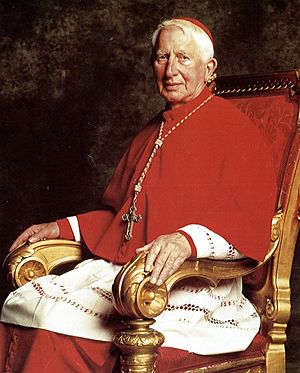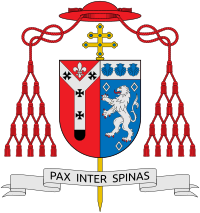Basil Hume facts for kids
Quick facts for kids His Eminence Basil Hume OSB OM |
|
|---|---|
| Cardinal, Archbishop of Westminster Primate of England and Wales |
|
 |
|
| Church | Roman Catholic Church |
| Province | Westminster |
| Appointed | 9 February 1976 |
| Enthroned | 25 March 1976 |
| Reign ended | 17 June 1999 |
| Predecessor | John Carmel Heenan |
| Successor | Cormac Murphy-O'Connor |
| Other posts | Cardinal Priest of San Silvestro in Capite |
| Orders | |
| Ordination | 23 July 1950 |
| Consecration | 26 March 1976 by Bruno Heim |
| Created Cardinal | 24 May 1976 |
| Rank | Cardinal priest |
| Personal details | |
| Birth name | George Haliburton Hume |
| Born | 2 March 1923 Newcastle upon Tyne, England |
| Died | 17 June 1999 (aged 76) London, England |
| Buried | Chapel of St Gregory and St Augustine, Westminster Cathedral, London |
| Nationality | British |
| Denomination | Roman Catholic |
| Parents |
|
| Previous post | Abbot of Saint Lawrence's Abbey, Ampleforth (1963–1976) |
| Coat of arms |  |

George Basil Haliburton Hume OSB OM (2 March 1923 – 17 June 1999) was an English Catholic bishop. He was a monk and priest of the English Benedictine monastery of Ampleforth Abbey and its abbot for 13 years until his appointment as Archbishop of Westminster in 1976. His elevation to a cardinal followed during the same year. From 1979, Hume served also as president of the Catholic Bishops' Conference of England and Wales. He held these appointments until his death from cancer in 1999. His final resting place is at Westminster Cathedral in the Chapel of St Gregory and St Augustine.
During his lifetime, Hume received wide respect from the general public which went beyond the Catholic community. Following his death, a statue of him in his monastic habit and wearing his abbatial cross was erected in his home town of Newcastle upon Tyne outside St Mary's Cathedral (opposite Newcastle station); it was unveiled by Queen Elizabeth II.
Contents
Early life and ministry
Hume was born George Haliburton Hume at 4 Ellison Place in Newcastle upon Tyne in 1923, to Sir William Errington Hume (1879–1960) and Marie Elizabeth (née Tisseyre) Hume (d. 1979). His father was a Protestant and a cardiac physician from Scotland, and his mother the French Catholic daughter of an army officer. He had three sisters and one brother.
Hume was a pupil at the independent school Ampleforth College between the ages of 13 and 18. After finishing his studies there, he entered the novitiate of the Benedictine monastery at Ampleforth Abbey in North Yorkshire in 1941, at the age of 18. He received the habit and the monastic name of Basil. He was solemnly professed in 1945.
After Ampleforth, Hume went on to study at St Benet's Hall, Oxford, a Benedictine institution, where he graduated with a Bachelor of Arts in modern history. As it was impossible to study Catholic theology at Oxford at the time, he went on to the University of Fribourg, Switzerland, to complete his theological studies, earning a Licence in Sacred Theology.
Hume was ordained a priest on 23 July 1950. He then returned to Ampleforth to teach religious education, history, French and German. He served as head of the school's Department of Modern Languages before becoming the abbot of Ampleforth in 1963.
Hume was a lifelong fan of jogging, squash and Newcastle United F.C. He once described getting an autograph from Jackie Milburn, the Newcastle United legend, as one of his "proudest achievements".
Archbishop
On 9 February 1976, Hume was appointed Archbishop of Westminster, the highest ranking prelate in the Catholic Church in England and Wales, by Pope Paul VI. He was not considered the most obvious choice for the post of archbishop as he had lacked visible pastoral experience of running a diocese and, as the first monk to hold the post since the 1850 restoration of the English hierarchy, he was seen to be something of an outsider. Receiving news of the appointment during dinner, Hume later remarked, "I must confess I did not enjoy the rest of the meal."
Hume received his episcopal consecration on the following 25 March (the feast of the Annunciation) from Archbishop Bruno Heim in Westminster Cathedral. Bishops Basil Butler OSB and John McClean served as co-consecrators.
Cardinal
| Styles of Basil Hume |
|
|---|---|
 |
|
| Reference style | His Eminence |
| Spoken style | Your Eminence |
| Informal style | Cardinal |
Hume was created Cardinal-Priest of San Silvestro in Capite by Paul VI in the consistory of 24 May 1976. He was one of the cardinal electors in the conclaves of August and October 1978. He was considered by many the most "papabile" Englishman since Cardinal Pole in 1548–1550.
Even after becoming an archbishop, Hume never ceased to see himself as a Benedictine monk first and to interpret his duties in the light of those of a Benedictine abbot: "He must hate faults but love the brothers." (Rule of St Benedict, ch. 64:11).
Hume was seen as moderate in his theological positions, trying to please both liberals and conservatives. For instance, he accepted the validity of love between gay people. He was opposed to women priests but described most detractors of Humanae vitae as "good, conscientious and faithful".
Hume's time in office saw Catholicism become more accepted in British society than it had been for 400 years, culminating in the first visit of Queen Elizabeth II to Westminster Cathedral in 1995. He had previously read the Epistle at the enthronement of Robert Runcie as Archbishop of Canterbury in 1980. It was also during his tenure in Westminster that Pope John Paul II made a historic visit to England in 1982.
In 1998, Hume asked John Paul II for permission to retire, expressing the wish to return to Ampleforth and devote his last years to peace and solitude, fly fishing and following his beloved Newcastle United Football Club. The request was refused.
In April 1999, Hume revealed that he had terminal cancer. On 2 June of that year, Queen Elizabeth awarded him the Order of Merit. He died just over two weeks later, June 17, in Westminster, London, at age 76. After a funeral service broadcast live on national television, he was buried in Westminster Cathedral. John Paul II, in his message of condolence to the Church in England and Wales, praised Hume as a "shepherd of great spiritual and moral character".
Hume was the last Archbishop of Westminster to employ a gentiluomo. The gentiluomo were a form of ceremonial bodyguard who accompanied the archbishops on formal occasions. As the role had become archaic, no new gentiluomo were appointed after the death of Hume's gentiluomo, Anthony Bartlett OBE, in 2001.
Legacy

Hume was regularly named Britain's most popular religious figure in opinion polls and this was attributed by some to the great humility and warmth with which he treated everyone he met, regardless of their religion or background.
- A statue of Hume was erected in his home town of Newcastle and unveiled by the Queen in 2002.
- The Cardinal Hume Centre based in Westminster works to improve the lives of homeless young people, families and other vulnerable and socially excluded members of society.
- The Cardinal Hume Rose is named after him.
- Cardinal Hume Catholic School has been opened in Beacon Lough, part of Gateshead, Tyne and Wear. It replaces the ageing St Edmund Campion School and accommodates over 1,000 students.
- The Hume Theatre of St Mary's Catholic School, Bishop's Stortford, is named after him. He opened it a few years before he died.
- The Hume building of St. Mary's Menston school, opened in 2001, is named after him.
- The Basil Hume Scholarship is a set of scholarships awarded to new pupils at Ampleforth College.
Orders, medals and decorations
National orders
Foreign orders
 Sovereign Military Order of Malta: Order pro merito Melitensi
Sovereign Military Order of Malta: Order pro merito Melitensi
Other
- Member of the Athenaeum Club, London
- Order of Saint Lazarus (statuted 1910)
See also
 In Spanish: Basil Hume para niños
In Spanish: Basil Hume para niños
- Anthony Howard, author of "Basil Hume, the monk cardinal", Headline, 2005 (ISBN: 0-7553-1247-3).
- Westminster Cathedral

